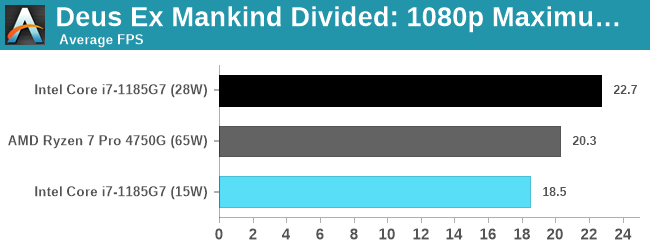Intel’s Tiger Lake 11th Gen Core i7-1185G7 Review and Deep Dive: Baskin’ for the Exotic
by Dr. Ian Cutress & Andrei Frumusanu on September 17, 2020 9:35 AM EST- Posted in
- CPUs
- Intel
- 10nm
- Tiger Lake
- Xe-LP
- Willow Cove
- SuperFin
- 11th Gen
- i7-1185G7
- Tiger King
Xe-LP GPU Performance: Deus Ex Mankind Divided
Deus Ex is a franchise with a wide level of popularity. Despite the Deus Ex: Mankind Divided (DEMD) version being released in 2016, it has often been heralded as a game that taxes the CPU. It uses the Dawn Engine to create a very complex first-person action game with science-fiction based weapons and interfaces. The game combines first-person, stealth, and role-playing elements, with the game set in Prague, dealing with themes of transhumanism, conspiracy theories, and a cyberpunk future. The game allows the player to select their own path (stealth, gun-toting maniac) and offers multiple solutions to its puzzles.
DEMD has an in-game benchmark, an on-rails look around an environment showcasing some of the game’s most stunning effects, such as lighting, texturing, and others. Even in 2020, it’s still an impressive graphical showcase when everything is jumped up to the max.


At the minimum settings, all of the integrated graphics are easily playable, with AMD winning at 15 W but the 28 W Tiger Lake goes a bit above that, within reaching distance of the desktop APU. At a more regular 1080p Maximum, the 20 FPS is perhaps a bit too slow for regular gameplay.











253 Comments
View All Comments
ikjadoon - Thursday, September 17, 2020 - link
You wrote this twice without any references, but I'll just write this once:AMD is literally moving to custom Wi-Fi 6 modems w/ Mediatek (e.g., like ASMedia and AMD chipsets): https://www.tomshardware.com/news/report-amd-taps-...
PCIe4: it doesn't need to 'max out' a protocol to be beneficial and likewise allows fewer lanes for the same bandwidth (i.e., PCIe Gen4 also powers the DMI interface now, no?).
Thunderbolt 4 is genuinely an improvement over USB4. Anandtech wrote an entire article about TB4: https://www.anandtech.com/show/15902/intel-thunder... (mandates unlike USB4, 40 Gbps, DMA protection, wake-up by dock, charging, daisychaining, etc). Anybody who's bought a laptop in the past two years know that "USB type-C" is about as informative as "My computer runs an operating system."
AVX512 / DLboost: fair, nobody cares on a thin-and-light laptop.
LPDDR5 is likely coming in 2021 to a Tiger Lake refresh around CES. Open game how many OEMs will wait; noting very few of the 100s of laptop design wins have been released, I suspect many top-tier notebooks will wait.
Billy Tallis - Thursday, September 17, 2020 - link
I'd be surprised if the chipset is using gen4 speeds for the DMI or whatever they call it in mobile configurations. The PCIe lanes downstream of the chipset are all still gen3 speed, so there's not much demand for increased IO bandwidth. And last time, Intel took a very long time to upgrade their chipsets and DMI after their CPUs started offering faster PCIe on the direct attached lanes.JayNor - Saturday, September 19, 2020 - link
4 lanes of pcie4 are on the cpu chiplet, as are the thunderbolt io. They can be used for GPU or SSD.Billy Tallis - Saturday, September 19, 2020 - link
Did you mean to reply to a different comment?RedOnlyFan - Friday, September 18, 2020 - link
Lol this is so uneducated comment. Telling wrong stuff twice doesn't make it correct.Pcie4 implemented properly should consume less power than pcie3.
Thunderbolt 4 is not USB 4. Only tb3 was open sourced to USB 4 so USB 4 will be a subset for tb3 thank Intel for that.
There are more AI/ML used in the background than you realize. If you expect people to do highly multi threaded rendering stuff.. Why not expect AI/ML stuff?
And 2022 is still 1.5 year away. So amd is entering the party after its over.
JayNor - Saturday, September 19, 2020 - link
Thunderbolt 4 doubles the pcie speed vs Thunderbolt 3 that was donated for USB. Intel has also now donated the Thunderbolt 4 spec.Spunjji - Friday, September 18, 2020 - link
They have 4 (four) lanes of PCIe 4.0 - that provides the same bandwidth as Renoir's 8 lanes of 3.0I get that you're one of those posters who just repeats a list of features that Intel has and AMD doesn't in order to declare a "win", but seriously, at least pick one that provides a benefit.
JayNor - Saturday, September 19, 2020 - link
The m.2 pcie4 chips use 4 lanes. Seems like a good combo with Tiger Lake. AMD would need to use up 8 lanes to match it with their current laptop chips.Rudde - Saturday, September 19, 2020 - link
Problem is that there isn't any reasonable mobile pcie4 SSDs yet. Same problem with lpddr5. Tiger Lake will get them when they become available. Renoir was released half a year ago; all AMD based laptops will wait for next gen before adopting these technologies anyway.If you want to argue that AMD is behind, highlight what Ice Lake has, but Renoir doesn't have.
Spunjji - Saturday, September 19, 2020 - link
Why would they bother? There are no performance benefits to using a PCIe 4 SSD in the kinds of systems TGL will go into. You can't get data off it fast enough for the read speed to matter, and it has no effect on any of the applications anyone is likely to use on a laptop that has no GPU. This is aside from Rudde's point about there currently being no products that suit this use case.